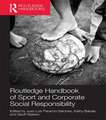Organizational Behaviour in Sport: Foundations of Sport Management
Autor James Skinner, Bob Stewarten Limba Engleză Paperback – 22 mai 2017
The book explores behaviour on individual, interpersonal, group and whole-organization levels, and presents an evidence-based framework for analysis built around key concepts such as:
- Change and culture
- Leadership
- Motivation, rewards and incentives
- Power and influence
- Conflict, disputes and grievances
- Equity, diversity and inclusion.
| Toate formatele și edițiile | Preț | Express |
|---|---|---|
| Paperback (1) | 426.70 lei 6-8 săpt. | |
| Taylor & Francis – 22 mai 2017 | 426.70 lei 6-8 săpt. | |
| Hardback (1) | 1116.77 lei 6-8 săpt. | |
| Taylor & Francis – 23 mai 2017 | 1116.77 lei 6-8 săpt. |
Preț: 426.70 lei
Preț vechi: 501.99 lei
-15% Nou
Puncte Express: 640
Preț estimativ în valută:
81.65€ • 85.48$ • 67.56£
81.65€ • 85.48$ • 67.56£
Carte tipărită la comandă
Livrare economică 05-19 aprilie
Preluare comenzi: 021 569.72.76
Specificații
ISBN-13: 9780415671767
ISBN-10: 0415671760
Pagini: 262
Ilustrații: 7 Tables, black and white; 16 Line drawings, black and white; 23 Illustrations, black and white
Dimensiuni: 174 x 246 x 14 mm
Greutate: 0.44 kg
Ediția:New.
Editura: Taylor & Francis
Colecția Routledge
Seria Foundations of Sport Management
Locul publicării:Oxford, United Kingdom
ISBN-10: 0415671760
Pagini: 262
Ilustrații: 7 Tables, black and white; 16 Line drawings, black and white; 23 Illustrations, black and white
Dimensiuni: 174 x 246 x 14 mm
Greutate: 0.44 kg
Ediția:New.
Editura: Taylor & Francis
Colecția Routledge
Seria Foundations of Sport Management
Locul publicării:Oxford, United Kingdom
Public țintă
Postgraduate and UndergraduateCuprins
Introduction: Organisational Behaviour in Sport
1. Sport’s Special Features
2. Organisational Design and Structure
3. Culture and Climate
4. Job Analysis and Selection
5. Orientation and Induction
6. Rewards Systems
7. Training and Development
8. Personality
9. Perceptions
10. Motivation
11. Attitudes, Emotions, and Job Satisfaction
12. Group Behaviour
13. Team Dynamics
14. Interpersonal Communication
15. Leadership
16. Safety and Risk
17. Stress and Aggression
18. Conflict Management and Resolution
19. Power and Politics
20. Bargaining and Negotiation
21. Change and Re-alignment
1. Sport’s Special Features
2. Organisational Design and Structure
3. Culture and Climate
4. Job Analysis and Selection
5. Orientation and Induction
6. Rewards Systems
7. Training and Development
8. Personality
9. Perceptions
10. Motivation
11. Attitudes, Emotions, and Job Satisfaction
12. Group Behaviour
13. Team Dynamics
14. Interpersonal Communication
15. Leadership
16. Safety and Risk
17. Stress and Aggression
18. Conflict Management and Resolution
19. Power and Politics
20. Bargaining and Negotiation
21. Change and Re-alignment
Notă biografică
James Skinner is the Director of the Institute for Sport Business and Professor of Sport Business at Loughborough University London, UK. His primary research interests are in leadership, culture and change in sport.
Bob Stewart is a Professor of Sport Management in the College of Sport and Exercise Science at Victoria University, Australia. His primary research interests are in the field of sport policy, culture and the regulation of sport.
Bob Stewart is a Professor of Sport Management in the College of Sport and Exercise Science at Victoria University, Australia. His primary research interests are in the field of sport policy, culture and the regulation of sport.
Recenzii
"A number of textbooks have been published that examine organisational behaviour issues in sport. They are all highly instructive, but tend to do it in conventional ways by taking generic models of organisational theory, group dynamics, and interpersonal relations, and inserting a few sport-related cases. This book is different because it first and foremost provides a detailed contextual frame that both connects sport to the world of business, and sets it apart from it. Within this strong sport-business frame it uses hardened theories of workplace behaviour to illuminate the ways sport works, and how it can ultimately work better. In taking this approach this book highlights the various individual, interpersonal and organisational behaviours that occur when delivering the sport product to its various stakeholders.
The book has three additional strengths:
First, it is written by two highly experienced sport management academics: James Skinner is Director of the Institute for Sport Business, and Professor of Sport Business, at the London campus of Loughborough University in the UK. Bob Stewart is the Sport Management Program Director at the College of Sport and Exercise Science at Victoria University in Melbourne in Australia. Between them, Bob and James have 40 years of teaching and research experience. They have also published more than 20 books that examine the commercial, social and cultural development of sport. They have the ideal background for putting together a book that examines the complex behaviours of people working in sport setting, be they highly bureaucratised sport businesses, or informal community associations and clubs. They both write very clearly and concisely and bring prosaic theories and concepts to life by linking them to highly grounded cases and incidents. This fusion of theory and practice threads its way through the entire book, and places it in a league of its own.
Second, the book has something for everyone. There are 21 succinctly written chapters together with more than 40 cases that cover everything you wanted to know about managing people in sport settings. Specific chapters are allocated to sport’s special features, organisational design and structure, culture and climate, job analysis and selection, orientation and induction, rewards and incentives, training and development, personality, perception, motivation, emotions, attitudes and job satisfaction, group behavior, team dynamics, interpersonal communication, safety and risk, stress and aggression, conflict, misbehaviour and dispute resolution, power and politics, bargaining and negotiation, and, finally, change and organisational realignment. The coverage is broad, but it is also deep.
Finally, everything is superbly glued together by the overarching proposition that sport enterprises will only fulfil their potential if their staff – be they highly paid or volunteers – are managed in ways that enhance their technical skills, creative capabilities, and interpersonal sensitivities.
I unreservedly recommend this book to anyone who wants to find out how best to manage people working in the sport industry. Students and practitioners alike will find it a highly valuable resource that offers fresh insights at every turn of the page. Essential reading!" - Aaron Smith, Professor of Management, RMIT University, Australia
The book has three additional strengths:
First, it is written by two highly experienced sport management academics: James Skinner is Director of the Institute for Sport Business, and Professor of Sport Business, at the London campus of Loughborough University in the UK. Bob Stewart is the Sport Management Program Director at the College of Sport and Exercise Science at Victoria University in Melbourne in Australia. Between them, Bob and James have 40 years of teaching and research experience. They have also published more than 20 books that examine the commercial, social and cultural development of sport. They have the ideal background for putting together a book that examines the complex behaviours of people working in sport setting, be they highly bureaucratised sport businesses, or informal community associations and clubs. They both write very clearly and concisely and bring prosaic theories and concepts to life by linking them to highly grounded cases and incidents. This fusion of theory and practice threads its way through the entire book, and places it in a league of its own.
Second, the book has something for everyone. There are 21 succinctly written chapters together with more than 40 cases that cover everything you wanted to know about managing people in sport settings. Specific chapters are allocated to sport’s special features, organisational design and structure, culture and climate, job analysis and selection, orientation and induction, rewards and incentives, training and development, personality, perception, motivation, emotions, attitudes and job satisfaction, group behavior, team dynamics, interpersonal communication, safety and risk, stress and aggression, conflict, misbehaviour and dispute resolution, power and politics, bargaining and negotiation, and, finally, change and organisational realignment. The coverage is broad, but it is also deep.
Finally, everything is superbly glued together by the overarching proposition that sport enterprises will only fulfil their potential if their staff – be they highly paid or volunteers – are managed in ways that enhance their technical skills, creative capabilities, and interpersonal sensitivities.
I unreservedly recommend this book to anyone who wants to find out how best to manage people working in the sport industry. Students and practitioners alike will find it a highly valuable resource that offers fresh insights at every turn of the page. Essential reading!" - Aaron Smith, Professor of Management, RMIT University, Australia
Descriere
What makes a sport enterprise successful? How can managers working in sport improve organizational effectiveness through strategic behaviour management? This comprehensive and accessible textbook addresses these important questions and examines the theories that underpin organizational analysis in sport. Helping both students and practitioners to understand the different types of behaviour that occur within a sports enterprise, it also demonstrates how to develop ways of managing behaviour more effectively for the benefit of all stakeholders. With international case studies, learning objectives, review questions and guides to further reading included in every chapter, no other textbook develops critical skills or an awareness of ethical issues in such detail and depth.






















